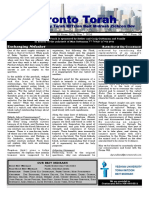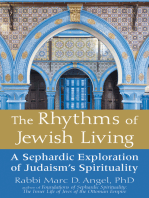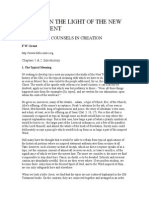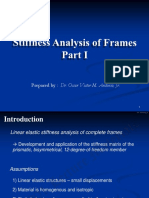1 SE Bereshit
1 SE Bereshit
Uploaded by
Adrian CarpioCopyright:
Available Formats
1 SE Bereshit
1 SE Bereshit
Uploaded by
Adrian CarpioCopyright
Available Formats
Share this document
Did you find this document useful?
Is this content inappropriate?
Copyright:
Available Formats
1 SE Bereshit
1 SE Bereshit
Uploaded by
Adrian CarpioCopyright:
Available Formats
Sefat Emet on the Parsha
Bereishit
*Please note that all citations are from the Sefat Emet, unless otherwise indicated. I will usually be offering
original translations, but this week I have drawn from Art Green’s selected translation, The Language of Truth.
Welcome to 5782. Welcome to Breishit/Genesis and new beginnings. Welcome to the world of
the Sefat Emet, Rabbi Yehudah Aryeh Leib Alter of Gur (1847-1905).
We begin our studies together with one of the opening teachings of the book, recorded in the
first year of the Rebbe’s teachings, 1870. In it, he reflects on the very first of Rashi’s [Rabbi
Shlomo Yitzchaki, 1040-1105] commentaries on the Torah, which is itself a midrash rooted in
the first word of the Torah, Breishit, “In the beginning.” Why does the Torah--the story of the
Jewish people--begin here, he wonders. Why not with the legal material of later portions,
inaugurated by the commandment to mark the start of each month?
IN THE BEGINNING — Rabbi Yitzchak said: The Torah which is the Law book of
Israel should have commenced with the verse (Exodus 12:2) “This month shall be unto
you the first of the months” which is the first commandment given to Israel. What is the
reason, then, that it commences with the account of the Creation? Because of the thought
expressed in the text (Psalms 111:6) “He declared to His people the strength of His works
(i.e. He gave an account of the work of Creation), in order that He might give them the
heritage of the nations.” For should the peoples of the world say to Israel, “You are
robbers, because you took by force the lands of the seven nations of Canaan”, Israel may
reply to them, “All the earth belongs to the Holy One, blessed be He; He created it and
gave it to whom He pleased. When He willed He gave it to them, and when He willed He
took it from them and gave it to us” (Yalkut Shimoni on Torah 187).
This question, posed by Rabbi Yitzchak, presumes the central importance of mitzvot
(commandments) to the life of the Jew. Our collective story should have begun with laws, he
suggests, because it is laws, commanded actions, that define us. It is laws that enable human
1|Sefat Emet on the Parshah
Rabbi Dr. Erin Leib Smokler
© Institute for Jewish Spirituality 2021
contact with divinity; laws that govern how we might be with God. The great narrative of the
Torah should have begun with a commandment because we are, essentially, a commanded
people.
In response to his own question, Rabbi Yitzchak offers a theological justification for the
alternate beginning, the creation narrative. The creation story affirms God’s sovereignty over
the world and thus God’s “right” to apportion it as God sees fit, he suggests. Law is indeed
crucial to our self-understanding, he concedes, but so is politics.
The Sefat Emet, however, is not swayed. Indeed, in a noteworthy omission, he cites Rabbi
Yitzchak’s question, but not his answer.
“In the beginning” (Gen. 1:1). Rashi opens his commentary by quoting R. Yitzchak, who
asked why the Torah did not begin with: “This month is the first of months for you” (Ex.
12:2) [since that is the first commandment to Israel]. He answered by quoting, “He
declared to His people the power of His acts” (Ps. 111:6) ...
The ellipses are admittedly there (the equivalent of etc., in Hebrew), but the text cited
unquestionably surfaces a question without its stated resolution.
In place of the political turn of R. Yitzchak, the Sefat Emet offers a pedagogical one. God
started the Torah in this way to tell us something about what Torah is. The story of creation and
the tales of the Patriarchs that follow (all pre-legal)--the intermingling of divine words and
human actions--are the very essence of that holy teaching.
Its meaning is as follows: Indeed, Torah was revealed primarily for the commandments.
That is the Written Torah. But God also wanted to make it clear that all of creation,
including this world itself, had come about by the power of Torah. “In the beginning,” we
are told, means that “He looked into the Torah and created the world.” That is called Oral
Torah--and it depends upon human acts.
In these few words, the Gerrer Rebbe implicitly transforms an abstruse statement from the
Zohar: “The Holy One gazed into the Torah and created the world.”
The Torah was/is not a parchment document that served as an architectural plan for the built
universe. (Nor is it a political manifesto to settle scores.) It is sacred testimony to human
yearning and human reckoning with God. It is a way of life that is both created for and created
by human beings in active relationship with God. The early stories of creation actually create
Torah. “Out of their stories, Torah is made,” says the Rebbe. The actions of our ancestors, and
the stories we tell about them, become our eternal foundation.
2|Sefat Emet on the Parshah
Rabbi Dr. Erin Leib Smokler
© Institute for Jewish Spirituality 2021
The Sefat Emet here makes a radical claim about the nature of Torah in sharp contrast to a
received tradition. The Rabbinic tradition has long distinguished between Torah she’bichtav,
Written Torah, and Torah she’beal peh, Oral Torah. The written word is usually identified as
the Five Books of Moses and the Oral Torah refers to all of the commentaries built on top of
that initial revelation. The Sefat Emet argues instead that the Written Torah--etched in stone and
rigid--is circumscribed to law alone. It begins with the first law regarding new moons and ends
with the final commandment of writing a Torah. It is Rabbi Yitzchak’s Torah, so to speak. But
the Oral, spoken Torah--imbued with the breath of life--is to be found within human beings,
dynamic, creative, evolving human beings. It begins with creation and does not end. Indeed, it
precedes the Written Torah itself and seemingly outlasts it. The Oral Torah, which begins “in
the beginning,” is sourced by the Source of Life, animated by human life, and in turn endows
the world with vitality, or chiyut.
Creation, on this read, importantly reflects the synchrony between divine energy and human
flourishing. Through maaseh breishit, the act of creation, God injects koach maasav, God’s
own power, into those of God’s people (amo) and amplifies their power in turn. This dynamic is
similarly reflected in another verse quoted by the Sefat Emet, Isaiah 51:16.
I have put my words in your mouth, and sheltered you with My hand; I, who planted the
skies and made firm the earth, have said to Zion you are My people.
Focusing on the last phrase, the Rebbe, in line with our Sages, reads ami, my nation, as imi,
with me. God says to God’s people, Zion, “You are with Me” as partners in creation--creation
of the world and creation of Torah.
There is yet one more word reworked by the Sefat Emet in this verse, one that comes to anchor
an idea that will permeate the book that lies before us, Zion.
The word “Zion” in this verse refers to the point [nekudah] that exists within each thing,
an imprint or sign that reminds us of its divine origin. It is this force [chiyut] that gives
life to all. The person who is joined to this inner point [nekudah], and all of whose life
[chiyuto] is drawn to this point, indeed becomes a partner in the act of creation.
Zion is not a place and it is not a people here. It is an invitation. Building on the resonances of
the Hebrew verb ‘le’tzyen,’ meaning ‘to point out or to distinguish,’ the Gerrer Rebbe
understands Isaiah’s statement to mean that God calls us to locate our inner point, our nekudah,
that distinguishes us as individuals and joins us to our inner Source. We all contain an “imprint”
of the divine, a gift of creation and a pull toward creation. This subtle force grounds us and it
also impels us forward into the swirl of life. It enlivens us, sets us in motion, gives us chiyut, or
vitality. When we attune ourselves to this inner nekudah, when we actively make space for its
3|Sefat Emet on the Parshah
Rabbi Dr. Erin Leib Smokler
© Institute for Jewish Spirituality 2021
powerful emergence and recognize its powerful origins, we become most ourselves, most
Godly, most partners in the act of creation. We are each enchanted and we contribute to the
enchantment of the world.
Genesis begins with the story of creation because that is our essential story and our guiding
task. We are created and creative beings, endowed with a spark of divinity within, marked by a
capacity to transform worlds without. Our actions, like the actions of our ancestors, generate
forcefields. They also create a dynamic Oral Torah, understood by the Sefat Emet to be the
stories that we make and the stories that we tell out our lives lived with chiyut, spiritual passion,
conviction, and devotion.
Reflection
In this opening essay, the Sefat Emet begins to talk about the nekudah, a theme that he and we
will return to again and again. Consider your own point of divinity, or essence, or inner core of
authenticity. When do you feel most alive? What gives you energy? Where do you feel most
generative? What would it take for you to truly, fully, self-consciously live your life?
He also talks about the radical idea that we human beings create Torah, that the fabric of our
lives is the holy script of our people. How does that inform your understanding of what Torah
is? And of who you are?
As we start the new year together, let us aim to pay attention to our nekudah points; to cultivate
vitality; to live Torah and to create Torah, as inheritors of our ancestors’ stories and as mindful,
powerful agents of our own.
4|Sefat Emet on the Parshah
Rabbi Dr. Erin Leib Smokler
© Institute for Jewish Spirituality 2021
You might also like
- Yitzchak Luria - Apples From The OrchardDocument767 pagesYitzchak Luria - Apples From The OrchardArturo Montiel100% (8)
- Tony Lane - The Wrath of God As An Aspect of The Love of GodDocument30 pagesTony Lane - The Wrath of God As An Aspect of The Love of GodJona Than100% (2)
- Hebrew Mind Verses Greek MindDocument33 pagesHebrew Mind Verses Greek MindFlor Maria De Ramirez100% (1)
- 600,000 SoulsDocument15 pages600,000 SoulsYehoishophotOliver100% (1)
- The Four WorldsDocument105 pagesThe Four WorldsDaniel Sultan100% (2)
- Reading The Book of Exodus LiturgicallyDocument90 pagesReading The Book of Exodus Liturgicallyapi-303640034100% (1)
- The Hidden Name of The Creator in Your DNADocument5 pagesThe Hidden Name of The Creator in Your DNAactool100% (1)
- TC Volume 1 SampleDocument22 pagesTC Volume 1 SamplearizagameroNo ratings yet
- From the Guardian's Vineyard on Sefer B'Reshith : (The Book of Genesis)From EverandFrom the Guardian's Vineyard on Sefer B'Reshith : (The Book of Genesis)No ratings yet
- Genesis Lesson 1Document11 pagesGenesis Lesson 1pastorrlc8852No ratings yet
- Nefashot: ExchangingDocument4 pagesNefashot: Exchangingoutdash2No ratings yet
- The Rhythms of Jewish Living: A Sephardic Exploration of Judaism's SpiritualityFrom EverandThe Rhythms of Jewish Living: A Sephardic Exploration of Judaism's SpiritualityRating: 3 out of 5 stars3/5 (2)
- The Torah and Its Rewards: Artscroll Siddur)Document4 pagesThe Torah and Its Rewards: Artscroll Siddur)outdash2No ratings yet
- Genesis Decoded: Esoteric Interpretations from the First Book of the BibleFrom EverandGenesis Decoded: Esoteric Interpretations from the First Book of the BibleNo ratings yet
- Staking Our Claim To The Land: Rabbi Moshe Chaim SosevskyDocument3 pagesStaking Our Claim To The Land: Rabbi Moshe Chaim Sosevskyoutdash2No ratings yet
- 01 Arizal Parshas BereishitDocument20 pages01 Arizal Parshas BereishitSebastianPalen100% (1)
- Genesis in The Light of The New Testament-F W GrantDocument73 pagesGenesis in The Light of The New Testament-F W Grantcarlos sumarchNo ratings yet
- The Sanctity of The Whole: Parashah Insights Rabbi Yaakov HillelDocument8 pagesThe Sanctity of The Whole: Parashah Insights Rabbi Yaakov HillelHarav Michael ElkohenNo ratings yet
- Keys to Help You Unlock the Bible: A Metaphysical InterpretationFrom EverandKeys to Help You Unlock the Bible: A Metaphysical InterpretationNo ratings yet
- Yada Yah - Volume 1 in The Beginning - 01 - Hayah - Existence - in The Beginning...Document58 pagesYada Yah - Volume 1 in The Beginning - 01 - Hayah - Existence - in The Beginning...yadayahNo ratings yet
- "Binding To Purpose" 1 1: Part TwoDocument10 pages"Binding To Purpose" 1 1: Part TwoEd NydleNo ratings yet
- Drawing Spirit RevisedDocument2 pagesDrawing Spirit RevisedEd NydleNo ratings yet
- In This Issue: Hada'at Finished With The Ultimate Moral Code, The TorahDocument12 pagesIn This Issue: Hada'at Finished With The Ultimate Moral Code, The Torahoutdash2No ratings yet
- Mysteries of GenesisDocument187 pagesMysteries of GenesisXavier LoboNo ratings yet
- The Decad of CreationDocument16 pagesThe Decad of CreationincoldhellinthicketNo ratings yet
- Grafted inDocument9 pagesGrafted inHaSophimNo ratings yet
- Parashah 1 - B'Reisheet 5777Document14 pagesParashah 1 - B'Reisheet 5777HaSophim100% (1)
- Secret of Brit BookDocument33 pagesSecret of Brit BookDavid Saportas Lièvano100% (1)
- Secret References to Christ In the Old testament ScripturesFrom EverandSecret References to Christ In the Old testament ScripturesNo ratings yet
- Mysteries of Genesis FillmoreDocument255 pagesMysteries of Genesis FillmoreTyrone Brackens100% (2)
- Gematria - Numbers and LettersDocument13 pagesGematria - Numbers and LettersJames Driscoll100% (1)
- Genesis 1:1 The Creation and The CreatorDocument18 pagesGenesis 1:1 The Creation and The Creatormatang_lawinNo ratings yet
- A Ruach Qadim Excerpt Paul The MysticDocument15 pagesA Ruach Qadim Excerpt Paul The MysticDaniel Constantine100% (1)
- Cube of Space The Tree of LifeDocument57 pagesCube of Space The Tree of LifeBruno Pythio100% (1)
- Parshat Mishpatim 5759 "These Are The Laws" Rabbi Ari KahnDocument7 pagesParshat Mishpatim 5759 "These Are The Laws" Rabbi Ari Kahngavriel76No ratings yet
- Parashah 1 - B'ReisheetDocument10 pagesParashah 1 - B'ReisheetHaSophimNo ratings yet
- Spiritual BeingDocument11 pagesSpiritual Beingsimone bennettNo ratings yet
- Hey! Is That The Letter "Hei?": Parashat Bereishit Tishrei 27 5776 October 10, 2015 Vol. 25 No. 4Document4 pagesHey! Is That The Letter "Hei?": Parashat Bereishit Tishrei 27 5776 October 10, 2015 Vol. 25 No. 4outdash2No ratings yet
- 1 God - S Call PDFDocument9 pages1 God - S Call PDFElla VelosoNo ratings yet
- Soul: Bible, Translation and ResponseDocument15 pagesSoul: Bible, Translation and Responsesobrino928No ratings yet
- The Hidden Name of The Creator in Your DNADocument6 pagesThe Hidden Name of The Creator in Your DNAAnonymous OuZdlENo ratings yet
- Exodus LessonDocument307 pagesExodus LessonDaryl BadajosNo ratings yet
- Kedushat LeviDocument66 pagesKedushat LeviJesse Glaser100% (2)
- Psalm 104: A Bodily Interpretation of Yahweh's History': J H. C D B R S U JDocument12 pagesPsalm 104: A Bodily Interpretation of Yahweh's History': J H. C D B R S U JScott DonianNo ratings yet
- Jewish Belies About Human NatureDocument21 pagesJewish Belies About Human NatureAlfredo III SantianesNo ratings yet
- Breakthrough SampleDocument16 pagesBreakthrough SampleShaft Mazimba (Son of Grace)No ratings yet
- Hebrew Word Studies From Genesis 1 1 2Document85 pagesHebrew Word Studies From Genesis 1 1 2maxnikhil565656No ratings yet
- The Cube of Space PDFDocument57 pagesThe Cube of Space PDFChris Walker100% (1)
- Freedom Agenda: Pesach 5771/2011Document40 pagesFreedom Agenda: Pesach 5771/2011vokkofNo ratings yet
- The Sefer Habrit and Naaseh V'nishmahDocument5 pagesThe Sefer Habrit and Naaseh V'nishmahoutdash2No ratings yet
- Lurianic KabbalahDocument33 pagesLurianic KabbalahLorena Araya RojasNo ratings yet
- The Revelation of Messiah#1Document32 pagesThe Revelation of Messiah#1Ed Nydle100% (2)
- 613 LawsDocument15 pages613 Lawsdavidpchristian100% (1)
- Reading The Book of Exodus LiturgicallyDocument86 pagesReading The Book of Exodus Liturgicallyapi-303640034No ratings yet
- 02 Luis CantilloDocument2 pages02 Luis CantilloAdrian CarpioNo ratings yet
- Gnome Level 2 BardDocument4 pagesGnome Level 2 BardAdrian CarpioNo ratings yet
- Kangee Crow SeasonedDocument2 pagesKangee Crow SeasonedAdrian CarpioNo ratings yet
- Kabbalat Shabbat Prayer Book 10.18.15 Final For EchaiDocument51 pagesKabbalat Shabbat Prayer Book 10.18.15 Final For EchaiAdrian CarpioNo ratings yet
- Cheat SheetDocument16 pagesCheat SheetAdrian CarpioNo ratings yet
- Notes From - Mormonism, What Everyone Needs To Know ®GDocument40 pagesNotes From - Mormonism, What Everyone Needs To Know ®GAdrian CarpioNo ratings yet
- Conan Character CONAN 4Document3 pagesConan Character CONAN 4Adrian CarpioNo ratings yet
- 14 SE Va'eraDocument7 pages14 SE Va'eraAdrian CarpioNo ratings yet
- 8 SE VaYishlachDocument8 pages8 SE VaYishlachAdrian CarpioNo ratings yet
- 27 SE TazriaDocument4 pages27 SE TazriaAdrian CarpioNo ratings yet
- 33 SE BechukotaiDocument5 pages33 SE BechukotaiAdrian CarpioNo ratings yet
- Stages of HolocaustDocument38 pagesStages of HolocaustAdrian CarpioNo ratings yet
- Moduel 4 Day 1 HitbodedutDocument3 pagesModuel 4 Day 1 HitbodedutAdrian CarpioNo ratings yet
- Jewish LiteratureDocument1 pageJewish LiteratureAdrian CarpioNo ratings yet
- 39 SE ChukatDocument6 pages39 SE ChukatAdrian CarpioNo ratings yet
- 11th Grade U.S. History NGSSS-SS Pacing Guide 1st 9 WeeksDocument21 pages11th Grade U.S. History NGSSS-SS Pacing Guide 1st 9 WeeksAdrian CarpioNo ratings yet
- 03-002 Thinking Like A Programmer - Pseudo Code IIDocument8 pages03-002 Thinking Like A Programmer - Pseudo Code IIzakdejonghNo ratings yet
- AudioCapDlg C PDFDocument14 pagesAudioCapDlg C PDFКонстантин К.No ratings yet
- Compiler Construction: M Ikram Ul Haq 1Document38 pagesCompiler Construction: M Ikram Ul Haq 1Ch Usman ZiaNo ratings yet
- Church of NorwayDocument15 pagesChurch of Norwayscott901No ratings yet
- 2023S2 - Ors216d Task V3Document5 pages2023S2 - Ors216d Task V3twisisanikNo ratings yet
- SAP SuccessFactors Employee Central PayrollDocument14 pagesSAP SuccessFactors Employee Central PayrollSuresh TNo ratings yet
- Recursion: Ashok Kumar SahooDocument37 pagesRecursion: Ashok Kumar SahooPriyanshu DimriNo ratings yet
- AEF1 File1 TestA AnswerSheetDocument1 pageAEF1 File1 TestA AnswerSheetPhakkdey ChanNo ratings yet
- Prepared By: Dr. Oscar Victor M. Antonio, JRDocument78 pagesPrepared By: Dr. Oscar Victor M. Antonio, JRheherson juanNo ratings yet
- Polity Printable MindmapDocument13 pagesPolity Printable MindmapEz WaniNo ratings yet
- Artificial Intelligence Project Report of Reasoning System For WeatherDocument12 pagesArtificial Intelligence Project Report of Reasoning System For WeatherGajendra gangwarNo ratings yet
- MTH101: Calculus I Lecture 5: Derivatives: International Burch UniversityDocument15 pagesMTH101: Calculus I Lecture 5: Derivatives: International Burch Universitylu cucuNo ratings yet
- C3-100 Installation GuideDocument2 pagesC3-100 Installation GuidejessvelazquezNo ratings yet
- KumarajivaDocument2 pagesKumarajivaPyo MaunggyiNo ratings yet
- Entity Concept: in AnthropologyDocument3 pagesEntity Concept: in AnthropologySagar ChhetriNo ratings yet
- NEUROLINGUISTIC PROGRAMMING FinalDocument47 pagesNEUROLINGUISTIC PROGRAMMING FinalYesenia Saavedra TiradoNo ratings yet
- Record Work Vocabulary For Competitive ExamsDocument2 pagesRecord Work Vocabulary For Competitive Examsmca23.gowsalyaNo ratings yet
- 2010 VU Intro To NVivo BookDocument33 pages2010 VU Intro To NVivo BookSalem HasanAliNo ratings yet
- Module 5 - OOPDocument22 pagesModule 5 - OOPsanjusinghpatna22No ratings yet
- All India Open Mathematics Scholarship Examination Std. III Mega Final June 2011Document4 pagesAll India Open Mathematics Scholarship Examination Std. III Mega Final June 2011muktaNo ratings yet
- (AC-S06) Week 06 - Pre-Task Quiz - Weekly Quiz INGLES IV (32827)Document5 pages(AC-S06) Week 06 - Pre-Task Quiz - Weekly Quiz INGLES IV (32827)piero montoyaNo ratings yet
- Module 03Document12 pagesModule 03manash20No ratings yet
- Curriculum ErickDocument3 pagesCurriculum ErickErick CervanteaNo ratings yet
- (1-3) Supply The Correct Verb FormsDocument3 pages(1-3) Supply The Correct Verb FormsTom CatNo ratings yet
- UiPath Certified Advanced RPA Developer v1.0 - EXAM DescriptionDocument7 pagesUiPath Certified Advanced RPA Developer v1.0 - EXAM DescriptionShrinivaas IyerNo ratings yet
- Arduino LCD KeyPad ShieldDocument6 pagesArduino LCD KeyPad ShieldIrving Zuñiga RiveraNo ratings yet
- Spanish 1 - Conjugation (Part 1)Document4 pagesSpanish 1 - Conjugation (Part 1)Joaquin100% (4)
- ChessDocument2 pagesChessJeraldine RepolloNo ratings yet
- EmersoncriticalessaycommDocument8 pagesEmersoncriticalessaycommapi-580484306No ratings yet









































































































